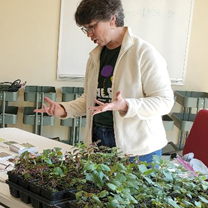By Coggin Heeringa, Interpretive Naturalist, Crossroads at Big Creek, Inc.

The big news at Crossroads is that (finally) we are replacing our Pike Passage Bridge. The original structure was removed last Wednesday, and, for the next few weeks, the sounds of heavy machinery will ring through the forest. Bridges are installed during the winter months to minimize disturbance to the land and to avoid the time during which fish spawn in the spring. Things may be messy during construction but understand that our bridge replacement is part of our multi-year restoration initiative to protect the creek and wetland ecosystems of Big Creek and The Cove Estuary.
Speaking of restoration, we are busy ordering plants and seeds and making plans for gardens and our land restoration projects. And we are hoping to attract new volunteers accomplish these plans by joining our Habitat Healers group. We also need volunteers for our educational and community science programs and other miscellaneous activities. On Friday at 5 p.m., we will host a Friends of Crossroads Mixer event to introduce volunteers to available opportunities. Join us and bring a dish to share if you’d like.
We are not alone in planning for the growing season. Many people are longing for spring and starting to plan their gardens. So, for their monthly gathering, Wild Ones of the Door Peninsula will offer “Butterfly Gardens 101.” The Crossroads Saturday Science Family Program will feature food webs. Those two topics are intricately connected.
Butterflies and moths are beautiful, and recently, these exquisite insects have been championed as pollinators. Actually, while butterflies and moths may carry pollen from flower to flower, they are in no way as efficient as native bees and honeybees. Butterflies land on long legs that do not get covered with pollen, and unlike bees, they make no effort to collect or carry it. They visit flowers to sip the sweet nectar.
Does that mean that butterflies and moths do not contribute to the environment? Hardly. In this region, moths and butterflies, or at least their larval form—caterpillars—drive the food web. The adult insects lay eggs on native host plants. Their caterpillars devour the leaves and become a nutritious, high-protein source of food for wildlife.
During breeding season, 96% of North American songbirds feed themselves and their offspring almost exclusive on caterpillars. So do an amazing number of wildlife creatures – from frogs, toads and reptiles to mice, fox, and even fish.
I thought I understood the food web – that energy from the Sun is captured by plants, and then animals eat plants and other animals eat them, so the energy is passed along. But until I read the book, “Bringing Nature Home: How You Can Sustain Wildlife with Native Plants,” by Douglas Tallamy, I did not realize that “insects are able to eat only vegetation from plants with which they share an evolutionary history.” In other words, most native Wisconsin insects can eat only one or two species of native Wisconsin plants. All other plants are, to them, distasteful or even poisonous.
So curiously, though butterflies and moths will visit non-native flowers, they lay their eggs only on natives … and they are fussy. Most people are aware that monarchs will lay eggs only on milkweeds, but this is not unusual. Almost all butterflies have one, maybe two host plants on which they can reproduce. So, people who want to encourage butterflies are most likely to succeed if they plant “host plants.” And (lecture spoiler alert), one of the best ways to attract butterflies to a home garden is to plant trees and shrubs known to be productive host plants.
Families (and learners of all ages) are invited to learn about host plants and food webs at our Saturday Science Program on Saturday, February 25. Drop in any time between 1:00-4:00 p.m. for hands-on activities.
During the Tuesday evening program sponsored by Wild Ones of the Door Peninsula, in collaboration with the Master Gardener Association, Naturalist Karen Newbern will describe garden flowers that will attract and provide nectar for adult butterflies, and suggest the native flowers, grasses and trees on which butterflies will lay their eggs. The program is free and open to the public. Plant lists will be available.Whether March comes in like a lion or like a lamb, the Junior Nature Club will meet indoors in the lecture hall of the Collins Learning Center on March 1. Puppeteer Nancy Hawkins will present the puppet folktale, “Grandfather Bear Is Hungry.” This program is for pre-school children and their companions and is free and open to all ages.
Crossroads at Big Creek Learning Center and Nature Preserve is located at 2041 Michigan. Crossroads is a 501(c)3 organization committed to offering education, conducting research and restoration, and providing outdoor experiences to inspire environmental stewardship in learners of all ages and from all backgrounds. We welcome your support! Become a member of Crossroads by mailing a contribution to P.O. Box 608, Sturgeon Bay, WI 54235, or donate online at crossroadsatbigcreek.org.


 ALL CONTENT © 2024 BY DOOR GUIDE PUBLISHING
ALL CONTENT © 2024 BY DOOR GUIDE PUBLISHING




